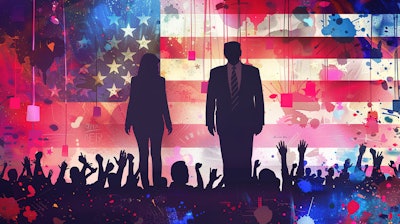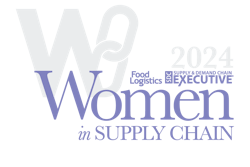
As the 2024 U.S. presidential election arrives and the end of the year quickly approaches, food and beverage (F&B) companies are facing a critical juncture. Right now, it’s crucial for these businesses to engage in strategic scenario planning to navigate the political shifts anticipated to impact the industry in 2025. The policies enacted by the incoming administration will significantly shape key areas for food manufactures, presenting both challenges and opportunities.
Kamala Harris has proposed policies focusing on labor rights, sustainability, and public health, which may foster innovation but could also impose operational burdens, particularly for companies with tighter profit margins.
In contrast, Donald Trump emphasizes deregulation and tax reductions, arguing that these measures will lower costs for producers, though potential labor and trade issues loom on the horizon.
Food pricing and inflation
Food prices have soared in recent years, driven by supply chain disruptions, labor shortages, and rising energy costs. In 2025, managing inflation will be a critical priority.
Harris aims to combat price gouging and enhance regulatory oversight in the food supply chain, particularly in sectors like meat processing, where monopolistic practices have inflated prices. Her focus on antitrust enforcement could foster competition and ultimately lead to lower prices. However, tighter regulations could increase compliance costs for large corporations, potentially raising operational costs in the short term.
Trump, conversely, promotes a strategy centered around deregulation to reduce production costs. He highlights energy costs as a primary driver of food price inflation, advocating for increased domestic oil production to lower fuel costs. This approach may stabilize food prices in the short term but could lead to long-term consequences, such as greater market volatility.
Labor shortages
Labor shortages continue to plague the industry, especially in processing plants and lower-wage jobs. The next administration’s stance on immigration reform and labor rights will significantly impact staffing levels within the F&B sector.
Harris advocates raising the federal minimum wage and improving workers’ rights through vocational training programs. This could help attract and retain a skilled workforce but may also increase operational costs for employers.
Trump’s stricter immigration policies could exacerbate labor shortages, particularly in agriculture and food processing sectors that rely heavily on migrant labor. However, his focus on reducing labor regulations might make it easier and cheaper for manufacturers to hire domestically, presenting a complex challenge for companies seeking to balance labor costs and workforce availability.
Climate change and sustainable practices
Both consumers and regulators are increasingly demanding sustainable practices from food producers, calling for reduced carbon emissions, less reliance on single-use plastics, and more sustainable sourcing of raw materials.
Harris supports policies that encourage businesses to shift to renewable, clean energy sources, which could impose stricter environmental requirements on the industry. This shift might lead to higher initial costs but could also foster long-term sustainability and resilience.
In contrast, Trump favors reducing environmental regulations to lower operational costs for food producers. His administration's approach could help stabilize short-term expenses but may come at the cost of longer-term environmental challenges that could affect the industry’s sustainability goals.
Trade and tariffs
International trade remains a significant concern for the food and beverage sector.
Trump’s plans to reinstate or increase tariffs on imports, particularly targeting China, could benefit some U.S. producers. However, this strategy could also hurt exporters of agricultural goods, such as soybeans and pork, who rely on international markets. Retaliatory tariffs from other countries could lead to price increases for consumers and disruptions in the supply chain.
Harris’s trade policies emphasize fair labor and environmental practices, which could protect U.S. manufacturers from unfair competition with countries that have lower standards. However, these policies may also limit access to cheaper imports of raw materials and food ingredients, potentially increasing production costs for food manufacturers.
Supply chain resilience
Building more resilient supply chains that can withstand future disruptions—whether due to pandemics, geopolitical conflicts, or climate change—continues to be a critical challenge. Policy decisions promoting domestic manufacturing and reducing reliance on imports will influence this landscape.
A new administration might prioritize infrastructure investment to improve logistics and reduce transportation costs for the industry. Conversely, shifts in foreign policy could cause volatility in global supply chains, especially for imported goods.
Trump’s policies may focus on reducing dependence on foreign suppliers and increasing domestic production capacity.
Harris may take a more integrated approach, considering infrastructure, technology, labor rights, and sustainability to create robust supply chains.
Food safety and regulation
Ensuring food safety will remain a top priority, with concerns about contamination, foodborne illnesses, and the integrity of the supply chain.
Harris may advocate for more stringent safety regulations, particularly around contamination prevention, labeling, and traceability. While these measures could increase compliance costs for manufacturers, they may also reduce the risk of foodborne illnesses, enhancing brand reputation.
Trump’s administration would likely roll back certain regulations to reduce compliance costs, but this could increase the risk of safety issues, potentially undermining consumer confidence and brand integrity.
Technological innovations
Advancements in food technology—such as lab-grown meat, precision fermentation, and AI-driven production—will continue to disrupt the industry. Regulatory clarity around these innovations will be crucial for companies looking to invest in new technologies.
Harris may advocate for more oversight, while Trump’s administration might prioritize fostering an innovation-friendly environment. Manufacturers may benefit from federal funding or tax incentives for adopting advanced technologies that improve efficiency.
Shaping 2025 and beyond
The food and beverage industry is poised for significant transformation in 2025, influenced by economic, social, and environmental factors. The policies of the next administration will play a pivotal role in determining how these challenges are addressed.
A Harris administration may focus on tighter regulations and sustainability, potentially leading to higher costs but improved food security.
A Trump administration could prioritize deregulation and lower costs, which may reduce prices but risk consolidation and trade disruptions.
Overall, F&B companies must remain vigilant and adaptable, preparing for a dynamic political landscape that will shape the future of the industry.



















